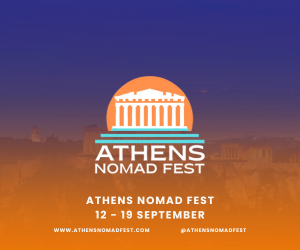LIFE & CULTURE
XpatAthens
Foodie Walk Tour
Foodie Walk Tour is a fun walking tour designed for foodies and anyone curious enough to explore downtown Athens and indulge in its culinary delicacies.
A “fun-tastic” way to acquaint yourself with the buzzing part of the city.
We will taste savory and sweet delicacies from family-owned stores, sustainable, locally sourced foods (usually a small batch), and artisanal cheese from the Greek islands during our walk. We will be introduced to authentic old-school vendors who boast about their all-around knowledge while we move on to how Greek traditional food adapts to today’s fashion.
Shopping arcades, hidden backstreets, and colorful markets will awaken your senses during the walking tour while your guide will explain the Greek culinary customs. Your impressions of the tour will be discussed with your guide, who will happily advise on further foodie recommendations and tips on where to find your ideal edible souvenirs to take back home.
Conde Nast Traveller: Patmos & Lipsi An Enchanting Experience For Tourists
Patmos, with its unspoiled landscapes and its cultural heart, is a real pleasure for the body and soul, the article said, pointing to the additional glamour provided by Unesco world heritage monuments such as the Cave of the Apocalypse and St John's Monastery, or the pretty central village of Chora, while providing everything that the modern tourist requires.
A few miles away, the island Lipsi offers a 'castaway' experience and seclusion, with Conde Nast describing it as the "ultimate switch-off destination" for enjoying the simple pleasures, such as swimming in its blue-green waters, hiking, and dining in traditional restaurants.
Originally published on: tornosnews.gr
Bolivar Beach Club Presents 2 Of The Biggest Dance Events
With a lineup reminiscent of something from TOMORROWLAND, the decks on July 8 will be taken over by the famous techno masquerade Boris Brejcha and the talented Ann Clue in order to give an explosive performance. Purchase your tickets here.

On July 9, Bolivar proudly hosts 4 unique DJs/producers, the favorite superstar Guy Gerber, the award winner with the best electronic live performance Recondite, the Woo York live that we met from their Afterlife productions, and the fast-rising and most sought-after Layla Benitez. Purchase your tickets here.

Flying Piano Over Tempi To Promote The Natural Heritage
Sunday afternoon, hikers and other visitors were stunned, when a woman appeared in the air with her piano that was floating in the air with the help of big balloons, creating an unreal scenery.
This unique event and promotion video was an idea of director Paschalis Mantis and the pianist of the Acropolis museum Elena Xydia who followed a call by the mayor of Tempi Municipality, Giorgos Manolis, in order to create a special video promoting the natural heritage of the area.
A volunteer team worked for some time planning the venture, which is unique as no one has attempted it before in a natural landscape, at such a great height.
With impeccable technical planning by Vassilis Badavis, all safety measures were foreseen, in this venture which was completely safe both in the preparation phase and in the final implementation phase.
It should be noted that the help offered by the Larissa Fire Brigade, the Police, and the Larissa Chamber of Commerce was very important and essential, the organizers said.
Originally published on: keeptalkinggreece.com
Great Self-Development Books To Add To Your Summer Reading List
New Piraeus Metro Stations To Open Before September
Speaking at the Technical Chamber of Greece’s conference “Green Deal Greece 2022” at the Stavros Niarchos Foundation Cultural Center, Kouretas said that the stations on the new Line 4 will be opened to the public at a date to be announced shortly.
In addition, he said, the Thessaloniki metro will be operational by the end of 2023.
“Along with the three Piraeus stations that we will hand over to the public in the next two months, Lines 2 [Red] and 3 [Blue] will end up serving over a million passengers a day, which means 200,000 fewer cars in Athens daily, and a reduction of 880 tons of carbon dioxide,” Kouretas said.
The metro will also bring an improvement to the urban landscape with the planting of trees while it will also serve major facilities such as hospitals.
To read this article in full, please visit: greece-is.com
Giannis Antetokounmpo: The Premiere Of RISE In Sepolia With NBA Stars
In Sepolia were also his Milwaukee teammates Pat Connaughton, Jevon Carter and Jordan Nwora along with two coaches, his managers and great basketball personalities such as Theodoros Papaloukas.
George Mazonakis was also there, along with the GM of Olympiacos, Nikos Lepeniotis.
Of course, several children rushed to see and deify Giannis Antetokounmpo and his brothers up close, creating a great atmosphere in an area that evokes memories for the Antetokounmpo family.
Celebrate The 4th Of July The American Way At Hard Rock Cafe Athens
The unique Rockin ’Refreshing cocktail - in the colors of the American flag - contains GRAY GOOSE vodka, lemonade, Grenadine, and Blue Curacao, garnished with delicious candies.
On the 4th of July, the restaurant will be specially decorated in a festive atmosphere, featuring the colors of America.
Except for Rockin ’Refreshing and‘ Red Blue White ’Burger, whoever chooses to visit the restaurant will be able to accompany their drink of choice with a wide range of mouth-watering main courses, starters, and delicious desserts. Gluten-free dishes will also be available.
For information and reservations, please call 210 3245170 or send an email to athens_salescoordinator@hardrock.com
Iggy Pop & Liam Gallagher Live In Athens
Iggy Pop, unique and incomparable, returns after the triumphant appearance of 2019 to give us a greatest-hits show full of his own inexhaustible energy.
Liam Gallagher, voice and soul of Oasis and one of the last real rock stars of our time, comes to Greece just at the moment when his solo career is taking off.
A landmark night for every rock music fan! With them, are the Sleaford Mods, the terrific duo from Nottingham, and The K's, one of the most emerging indie-rock bands on the British scene.
Taste Of Athens 2022
The hottest restaurants in town
The star chefs everyone is talking about, hard-to-book restaurants and the hottest (or coolest?) culinary projects are setting the scene of the largest gastronomic event in Greece.
All-day music & live concerts
Dance those calories away at the central Entertainment Stage, joining live acts from favorite artists and uplifting DJ sets at the fun epicenter of this year’s Festival! Make sure you lock your tickets in early to avoid missing out.
Family fun at the Kids Zone
Your little foodies will have a dedicated safe space with a fun-packed program of educational, creative and interactive sessions led by experienced professionals, so every member of your family can truly enjoy the tastes.














